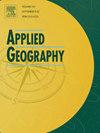城市轨道交通站区建设对城市街区传染病传播脆弱性的影响
IF 5.4
2区 地球科学
Q1 GEOGRAPHY
引用次数: 0
摘要
城市轨道交通导向发展(TOD)总是通过开发铁路车站区(rsa)来促进更广泛地区的经济、生态和社会可持续性。然而,人们对其对安全的影响,特别是面对疫情威胁时的影响关注较少。本研究以北京市为例,运用“无序多元logistic回归模型”的统计分析和ArcGIS可视化方法,探讨了RSA发展对城市街区传染病传播脆弱性影响的显著性和异质性。研究发现,城市街区人口脆弱性(PV)和建筑环境脆弱性(EV)的分布与轨道交通网络密切相关。具有较大RSA覆盖率的区块更有可能表现出高PV但不同的EV,具有高RSA轨道互通水平的区块更有可能表现出低EV但不同的PV。RSA商用服务水平的影响不显著。本研究验证了区块的PV和EV的增减可能是由于RSA发展的“时间差异”和“空间差异”造成的,突出了在RSA发展的不同场景下需要警惕。研究结果将有助于风险识别、遏制决策和安全与发展的综合规划。本文章由计算机程序翻译,如有差异,请以英文原文为准。
The effect of urban rail station area development on the vulnerability of city blocks to infectious disease spread
Urban rail transit-oriented development (TOD) always promotes the economic, ecological and social sustainability of wider areas by developing rail station areas (RSAs). However, less is focused on its influence on the safety, especially facing epidemic threats. This study explored the significance and heterogeneity of RSA development influencing the vulnerability of city-blocks to the spread of infectious diseases, using Beijing (China) case and applying the statistical analysis of ‘disordered multiple logistic regression model’ and the visualization method of ArcGIS. We found distributions of city-blocks’ population vulnerability (PV) and built environmental vulnerability (EV) are typically associated with the rail network. Blocks with a large RSA coverage are more likely to show high PV but different EV, blocks with a high RSA rail interchange level are more likely to exhibit low EV but different PV. The effect of the RSA commercial service level is insignificant. This study verified the growth and decline in the PV and EV of blocks are probably due to ‘temporal difference’ and ‘spatial difference’ of RSA development, highlighting the need to be vigilant in different scenarios of RSA development. The results will contribute to risk identification, containment decisions and integrative planning for safety and development in areas with RSAs.
求助全文
通过发布文献求助,成功后即可免费获取论文全文。
去求助
来源期刊

Applied Geography
GEOGRAPHY-
CiteScore
8.00
自引率
2.00%
发文量
134
期刊介绍:
Applied Geography is a journal devoted to the publication of research which utilizes geographic approaches (human, physical, nature-society and GIScience) to resolve human problems that have a spatial dimension. These problems may be related to the assessment, management and allocation of the world physical and/or human resources. The underlying rationale of the journal is that only through a clear understanding of the relevant societal, physical, and coupled natural-humans systems can we resolve such problems. Papers are invited on any theme involving the application of geographical theory and methodology in the resolution of human problems.
 求助内容:
求助内容: 应助结果提醒方式:
应助结果提醒方式:


